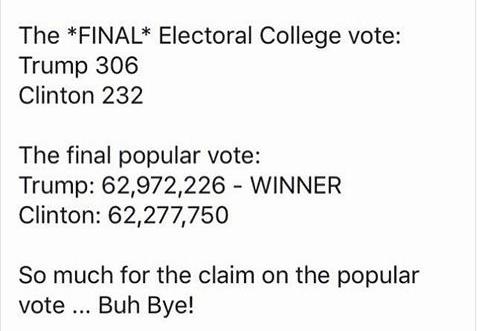As we described at length in a separate article, an unusual feature of the Electoral College system employed by the United States for presidential elections is that the candidate who receives the most votes overall nationwide (i.e., "wins the popular vote") does not necessarily win the election. On four occasions prior to 2016 (most recently in 2000), the Electoral College installed in the White House a president who received fewer popular votes than his opponent. This phenomenon seemingly recurred in 2016, when Hillary Clinton apparently won the popular vote by a considerable margin but lost the election to opposing candidate Donald Trump.
The electoral/popular vote disparity prompted calls and petitions for the Electoral College delegates to ignore their pledges and instead cast their ballots for Hillary Clinton, the putative winner of the popular vote:
That movement led to false claims that Donald Trump had, in fact, won a fully reckoned popular vote in addition to the electoral vote:
It also led to false claims that Donald Trump would prove to also be the winner of the popular vote if all the ballots cast were actually counted:
First of all, [Clinton's] probably not going to win the actual number of votes cast. She may win the number of votes counted, but not the votes cast. States don’t count their absentee ballots unless the number of outstanding absentee ballots is larger than the state margin of difference. If there is a margin of 1,000 votes counted and there are 1,300 absentee ballots outstanding, then the state tabulates those. If the number of outstanding absentee ballots wouldn’t influence the election results, then the absentee ballots aren’t counted.
As of 25 November 2016, the ballots counted so far show Hillary Clinton winning the national popular vote by a healthy margin of about 1.9 million votes:
Moreover, the popular vote margin favoring Hillary Clinton is likely to grow rather than shrink as more of the remaining ballots are counted. A spreadsheet compiled by David Wasserman, an editor at Cook Political Report who is tracking turnout, shows a similar trend, and as the Atlantic noted on 12 November 2016, the bulk of remaining uncounted ballots come from states that went heavily for the Democratic candidate:
“A majority of [uncounted ballots] are on the coasts, in New York, California, and Washington. She should be able to win those votes, probably 2-1.” By mid-December, when the Electoral College officially casts its ballots, Wasserman estimates that Clinton could be ahead by 2 percentage points in the popular vote.
What’s with the delay? Several states, notably California and Washington, have liberal absentee and mail-in voting laws. California, for instance, allows residents to submit ballots up to three days late (although they must be postmarked on or before Election Day). These provisions have made alternative voting pretty popular, and the ballots a bit harder to count. California alone has more than 4 million votes pending; Washington is waiting on another 700,000.
The notion that states don't count absentee ballots unless they are sufficient in number to change the outcome has been addressed (and refuted) by Vote.org:
Are absentee ballots counted?
Yes, all votes are counted, whether they're cast in-person or by absentee ballot.
It is a common misconception that absentee ballots are only counted during very tight races. This misconception stems from two things: one, absentee ballots are often counted for days after the election since many are coming from abroad; two, absentee ballots are often a small percentage of all voted ballots. Many elections have a clear winner, so the absentee ballots that are still being counted after election night don't affect the results as predicted right after the polls close. As absentee voting becomes more popular, however, an increasing number of elections are decided by absentee ballots.
Likewise, the web site of the Federal Voting Assistance Program (FVAP) states:
Many absentee ballots are cast by voters who are unable to vote at their physical polling place due to being an active duty military member, a family member of someone on active duty or a U.S. citizen residing overseas. All ballots submitted according to State laws are counted in every election.
The media often will report the projected outcome of the election before all of the ballots are counted. In a close election, the media may report that the outcome cannot be announced until after the absentee ballots are counted. However, all ballots, including absentee ballots, are counted in the final totals for every election, and every vote (absentee or in-person) counts the same.
But as satisfying (or disappointing) as it may be to Hillary Clinton supporters to see that more Americans voted for her than for any other candidate — including Donald Trump — that fact won't change the outcome in any way:
While these uncounted votes may grow Clinton’s popular lead, they absolutely will not change the course of the election. That math is settled; Trump holds an insurmountable lead in swing states, which turned his popular defeat into a sizable electoral victory. All the votes in liberal-leaning New York and California will not change that.



